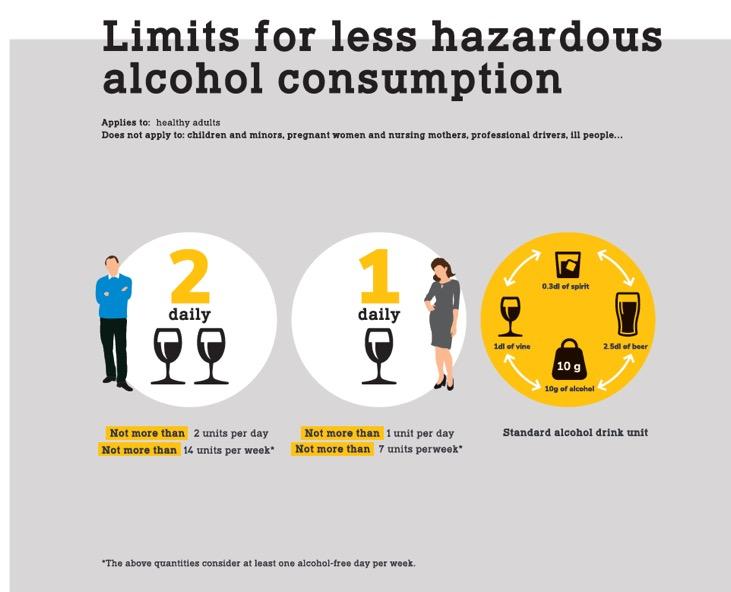Alcohol consumption
Excessive, hazardous and harmful alcohol consumption
Hazardous alcohol consumption is an act with a probability that an individual will suffer damage due to alcohol consumption. Harmful alcohol consumption is behaviour, which has already caused alcohol-related damage.
Where are the limits?
Alcohol consumption influences individuals differently. Nevertheless, experts set the rules and limits for less hazardous alcohol consumption for healthy adults, based on scientific research. Taking them into account lowers the probability of damage to health for the majority of healthy adults.
Limits for less hazardous alcohol consumption

(The road to) alcohol addiction
Alcohol addiction can be diagnosed in an individual in whom at least three of the following phenomena have been present in the last year (criteria set based on DSM-IV):
- increased tolerance, requiring an ever-increasing amount of alcohol to achieve the same effect;
- withdrawal symptoms that occur when alcohol consumption is discontinued and that subside when alcohol consumption is resumed;
- drinking alcohol in larger quantities and for a longer period of time than intended;
- unsuccessful attempts to quit drinking alcohol;
- an increasing amount of time spent drinking alcohol and recovering from its effects;
- giving up social, work-related, or other activities because of alcohol consumption;
- continued drinking despite harmful consequences caused by alcohol consumption.
It is recommended that you consult with your personal physician about your alcohol consumption. Few are able to overcome alcohol addiction without proper treatment.
Why focus on the issue of excessive alcohol consumption?
In Slovenia, two people die every day for reasons that are exclusively alcohol-related. Annually, this amounts to 650 individuals and the mortality rate is above the European average. In Slovenian hospitals, ten hospitalisations are recorded every day due to alcohol-related damage, yearly 3,876 on average.[1]
Data from research on tobacco, alcohol and illicit drugs (2015) indicates that in Slovenia, 43% of inhabitants aged between 25 and 64 drink alcohol over the limits of less hazardous alcohol consumption or got intoxicated in a highly hazardous way.[2] According to the CINDI 2016 study, the percentage of persons who get intoxicated once or three times per month or more often si increasing in Slovenia which is worrying.
According to NIJZ data, the registered alcohol consumption in 2016 in Slovenia was 10.5 litres of pure alcohol per inhabitant, older than 15.
[1] Zorko, M., Hočevar, T., Tančič Grum, A., Petrič, V.K., Radoš Krnel, S., Lovrečič, M., Lovrečič, B. Alcohol in Slovenia. Trends of drinking patterns, health consequences of harmful drinking, opinions of actors and suggestions of measures for a more effective alcohol politics. Ljubljana: NIJZ, 2014. V Roškar, M. et al. Alcohol politics in Slovenia. Opportunities for harm and costs reduction. Ljubljana: NIJZ, 2016.
[1] Koprivnikar, H., Zorko, M., Drev, A., Hovnik Keršmanc, M., Kvaternik, I., Macur, M. Uporaba tobaka, alkohola in prepovedanih drog med prebivalci Slovenije ter neenakosti in kombinacije te uporabe. Ljubljana: NIJZ, 2015.
